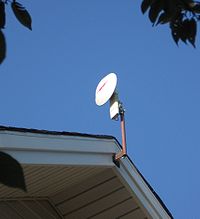- Motorola Canopy
-
Motorola Canopy Type of signal: LOS (line-of-sight), NLOS Maximum range (miles) 120 miles PtMP, 155 miles PtP [1] Minimum range: 500 m (The Subscriber Modules (SMs) do not like having a "full blast" signal) Maximum data throughput (Mbit/s) 21Mbit/s for PtMP, 300 Mbit/s using PTP 600. Motorola Canopy is a wireless networking system designed for wireless Internet service providers to provide Internet access. Product are available in point-to-point and point-to-multipoint configurations. It includes both the original Motorola-designed products using the Canopy protocol and the PtP backhauls that were rebranded from Orthogon Systems which Motorola acquired in 2006. Cambium Networks was created when Motorola Solutions sold the Canopy and Orthogon businesses in 2011.
Contents
Typical setup
A typical Canopy setup consists of a cluster of up to 6 co-located standard access points (APs), each with a 60 degree horizontal beamwidth antenna, to achieve 360 degree coverage. The most commonly used APs are now available in 120, 180, or even 360 degrees for site-based coverage, thus decreasing the need for so many APs on a tower. Also included would be one or more backhauls or otherwise out-of-band links (to carry data to/from other network occasions) and a Cluster Management Module (CMM) to provide power and synchronization to each Canopy AP or Backhaul Module (BM).
Customers of the system receive service through subscriber modules (SMs) aimed towards the AP. The SMs should be mounted on the tall point of a building to get a reliable connection else Fresnel zone obstruction will weaken the signal. Under ideal operating conditions connections at distances up to 3.5 miles can be achieved using equipment with integrated antennas. Network operators can opt to install reflector dishes or Stinger antennas, or to use Canopy models that accept external antennas at one or both ends of the link to increase coverage distance.
Most Canopy equipment receives its power using Power over Ethernet, however, none of its standards comply with IEEE 802.3af. A customer can query the status of their SM by entering this URL in a web browser: 169.254.1.1/main.cgi, except if the network operator has changed the IP address of the unit or has put the subscriber in a VLAN.
In general, the 900 MHz version is more effective for use in outlying areas because of its ability to penetrate through trees.[2] However, it requires careful installation due to the easy propagation of interference on that band. Other frequencies currently available are the 2.4 GHz, 5.2 GHz, 5.4 GHz, and 5.7 GHz versions.
Comparison with other wireless networking systems
These products are fixed wireless technology. Canopy protocol products have many advantages over Wi-Fi and other wireless local area network protocols:
- transmission timing is explicitly controlled, so that all APs on all towers can be synchronized by GPS to prevent interference. APs of the same band can be placed right next to each other, and back-to-back units can use exactly the same frequency.
- designed for WISP use; polling-based (prevents one SM from "hogging" bandwidth), excellent interference rejection and easy management.
- simple to install and configure and highly reliable.
Their main disadvantages are:
- proprietary - therefore only available from Motorola, at prices that can be expensive.
References
- ^ Solution Paper: Point-To-Point Solutions and WiMAX. Motorola. http://www.motorolaptp.com/library/?cat=6. Retrieved 2008-02-16.[dead link]
- ^ Motorola Canopy Wireless Broadband - 900 MHz Modules. Motorola. http://motorola.canopywireless.com/support/library/. Retrieved 2008-02-16.
External links
- "WISP Technician Wiki". http://www.wisptech.com. Retrieved July 18, 2011.
[[1]]
Categories:- Wireless networking
- Metropolitan area networks
- Network access
Wikimedia Foundation. 2010.


